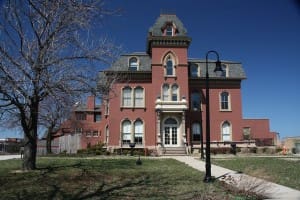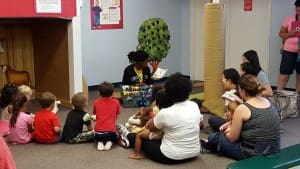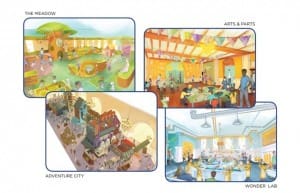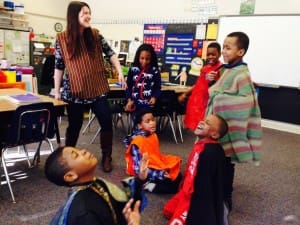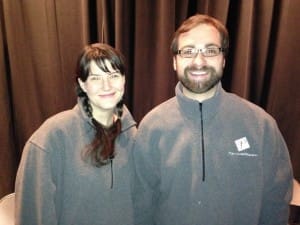2016 marks The Literacy Cooperative’s 10 year anniversary! To celebrate this milestone, we partnered with the Cleveland Bridge Builders Class of 2016 to showcase community organizations across Greater Cleveland that have incorporated literacy-based programs into their scope of service during the past 10 years. We asked them to write a post highlighting their journey, featuring the accomplishments, achievements and how they have helped the community learn and grow over the last ten years. We will be featuring the posts throughout the next few months.
This week’s guest blog post comes from Playhouse Square written by Daniel Hahn, Vice President of Engagement and Education

Imagine you are back in third grade. The school year has been underway for several weeks, and you are excited about the opportunities ahead. But you find yourself struggling to keep up with the reading assignments. Much of the vocabulary is unfamiliar. The classroom texts are above your comprehension level. And the state of Ohio is now under the government mandate called the “Third Grade Guarantee,” which dictates that third graders who do not pass the state reading exam will be retained at their grade level next school year. Your teachers are making every possible effort, but your struggles continue. You are on the academic bubble, and could go either way.
In 2013, Playhouse Square anticipated this scenario, and began developing a program to address it. Two of the region’s top teaching artists, Melissa Crum and Eric Perusek, were engaged to work with three handpicked elementary schools from three very different regions: Crestwood Elementary, in the Elyria City School District; Denison Elementary, in the Cleveland Metropolitan School District; and Oxford Elementary, in the Cleveland Heights-University Heights School District. These schools all had one thing in common: all three had third grade reading scores below the state of Ohio proficiency passage level of 75%. In 2013, Crestwood had 62.7% of third graders passing reading. Denison had 48.2%. Oxford had 53.7%. The genesis of this new program was to see if bringing literature to life in the classroom using drama as a learning medium might help improve students’ reading abilities.
In the late summer/early fall of 2013, Melissa, Eric and I met with teachers and administrators from our selected schools, and began studying the school year’s third grade reading lesson plans and benchmarks. We started crafting drama-based activities to implement in the classroom. In that developmental year, Melissa and Eric visited each school’s third grade classes approximately once every third week, on a rotating basis between schools. After just a few visits, the teachers invited our guest artists to begin testing out interactive lessons in the classroom. The student response was overwhelmingly positive. Third graders who previously were withdrawn were now volunteering for parts to be dramatized in front of their peers. Vocabulary words were shouted around a standing circle as part of a theater warm-up game. Students encouraged each other’s efforts and validated their successes.
With generous support from The Nordson Corporation Foundation and The Stocker Foundation, Playhouse Square was able to fund not only the teaching artists in this initial year, but to supply costumes, properties, and books as well. Before long, every third grade student in each school had a copy of Kate DiCamillo’s award-winning novel, “Because of Winn Dixie,” and began acting out passages of the story in their classroom under the guidance of Melissa and Eric. Words which before were unfamiliar became clearer in the performing of the story. Student enthusiasm was high, and feedback from the teachers was extremely positive.

Playhouse Square teaching artists Melissa Crum and Eric Perusek (photo by Daniel Hahn)
In that first developmental year, the teaching artists visited each school a dozen times, from September through May. Additionally, each school visit allocated planning time in the teacher’s lounge with the respective third grade teachers, to discuss upcoming lesson plans and strategize ways of deeply engaging the students. It’s difficult to ascertain whether or not the improvement in each school’s subsequent reading scores was directly related to this developmental year, but it is worth noting that Crestwood’s passage rate improved by 3%, Denison’s 7%, and Oxford’s 8% from 2013 to 2014.
After that initial developmental year, it was time to launch the pilot program in full. Beginning in the fall of 2014, instead of visiting each school just once every third week, the teaching artists visited once per week. This is a significant amount of time to ask a classroom teacher to allow guests to work in their classroom, so having the full support of the school team was essential. In addition to adding more classroom visits, a few other adjustments were made to the program in 2014-2015.
The teaching artists would now spend the entire school day at each school. Full classroom visits to each third grade class were scheduled, but in addition, Melissa and Eric would spend a second session with smaller groups of struggling readers, providing even more individualized, interactive instruction to reinforce the week’s lessons. Furthermore, Playhouse Square provided tickets and transportation for each participating class to attend performances of children’s plays at the Ohio Theatre in downtown Cleveland. For some students, this was their first ever experience attending live, professional theater. Student enthusiasm and teacher encouragement remained strong. At the end of the year, students at Crestwood Elementary performed selections from the year’s reading for their parents and families in the school gymnasium. It was a wonderful celebration.
Test results from this pilot year show varied outcomes. In part, this is likely because the state changed the reading test between 2013 and 2014, as Ohio opted for a more rigorous exam in the latter year, making a direct apples to apples comparison untenable. Other dynamics outside of the classroom environment also deeply impact learning, such as student transient rates, regional poverty levels, and of course the group of students’ individual abilities themselves. Still, the numbers are worth noting. Below are the scores showing the ODE test results for Third Grade Reading in the three schools in which the program was implemented, as well as scores of other schools in those same districts for comparison.
| All Elyria City Elementary Schools |
2014 |
2015 |
Variance |
| Elyria Crestwood |
65.8% |
69.7% |
3.9% |
| Elyria Ely |
82.6% |
68.7% |
-13.9% |
| Elyria Franklin |
56.3% |
45.1% |
-11.2% |
| Elyria McKinley |
77.9% |
73.2% |
-4.7% |
| Elyria Oakwood |
72.4% |
61.1% |
-11.3% |
| Elyria Prospect |
77.8% |
82.5% |
4.7% |
| Elyria Windsor |
75.8% |
87.0% |
11.2% |
|
|
|
|
| All Cleveland Heights Elementary Schools |
|
|
|
| Cleveland Heights Oxford |
61.7% |
66.7% |
5.0% |
| Cleveland Heights Roxboro |
89.8% |
83.6% |
-6.2% |
| Cleveland Heights Boulevard |
71.1% |
69.6% |
-1.5% |
| Cleveland Heights Canterbury |
91.0% |
92.0% |
1.0% |
| Cleveland Heights Fairfax |
75.0% |
70.0% |
-5.0% |
| Cleveland Heights Gearity |
79.6% |
59.2% |
-20.4% |
| Cleveland Heights Noble |
69.7% |
63.0% |
-6.7% |
|
|
|
|
| Sampling of CMSD Elementary Schools |
|
|
|
| CMSD Denison |
55.3% |
45.5% |
-9.8% |
| CMSD Charles Eliot |
57.1% |
50.0% |
-7.1% |
| CMSD Almira |
58.3% |
34.1% |
-24.2% |
| CMSD Franklin D Roosevelt |
52.0% |
27.5% |
-24.5% |
| CMSD Newton D Baker |
53.3% |
64.0% |
10.7% |
| CMSD Patrick Henry |
53.6% |
62.9% |
9.3% |
| CMSD Wade Park |
52.5% |
35.6% |
-16.9% |
| CMSD Watterson-Lake |
52.2% |
66.7% |
14.5% |
| CMSD Walton |
54.8% |
54.8% |
0.0% |
As you can see, Denison’s scores dropped by over 9%. While similar CMSD schools dropped even more precipitously under the more rigorous exam, others stayed flat or even improved. This makes evaluating the results at Denison even more challenging. At Crestwood in Elyria, a nearly 4% testing increase is encouraging, especially in comparison to the other schools in the district. And Oxford Elementary in Cleveland Heights showed the strongest improvement of any school in its district.
Still, a variety of conditions must be considered when looking at student learning. Playhouse Square’s Third Grade Literacy Program, now in its second year of full implementation, continues to make adjustments to maximize student learning based on in-classroom experiences and teacher feedback. With the continued support of our partners, we continue to work towards improving student learning.
Crestwood Elementary teacher Ann Coleman sums up her feelings about the Third Grade Literacy Program in this way: “Because of this program, my students are, without a doubt, better readers, writers, and communicators. Students are able to learn language arts in a creative, active, and meaningful way and have been able to apply the skills they have learned into other areas of the curriculum. I cannot imagine teaching language arts without this program!”
Learn more about Playhouse Square on their website: http://www.playhousesquare.org/.
Also be sure to follow them on Twitter and Facebook.
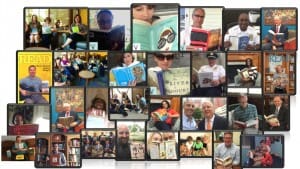

 The summer is winding down. How have you spent these warm weeks? On a family vacation? Taking walks in the park, playing at the beach? Going to festivals or amusement parks? How about reading together or doing a handful of math problems with your child once a day?
The summer is winding down. How have you spent these warm weeks? On a family vacation? Taking walks in the park, playing at the beach? Going to festivals or amusement parks? How about reading together or doing a handful of math problems with your child once a day? The summer is a great time to get children outside and active. You can create reading games, such as a vocabulary scavenger hunt. Label items throughout your yard or hide certain words in the trees and bushes. Have you child run about finding all the words and then use them to create sentences and stories. They are active and learning at the same time!
The summer is a great time to get children outside and active. You can create reading games, such as a vocabulary scavenger hunt. Label items throughout your yard or hide certain words in the trees and bushes. Have you child run about finding all the words and then use them to create sentences and stories. They are active and learning at the same time!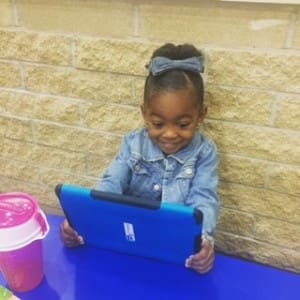 Do you love reading? Do you love children? Well, you’ll love the Reach Out & Read/ Ready to Learn Program here at the MetroHealth Broadway Center! Reach Out & Read/Ready to Learn was established in September 2014. Reach Out & Read/Ready to Learn encourages early reading habits with the parents and children through prescribing books to the families’ through child wellness visits. We have changed our waiting room into a “learning room”!
Do you love reading? Do you love children? Well, you’ll love the Reach Out & Read/ Ready to Learn Program here at the MetroHealth Broadway Center! Reach Out & Read/Ready to Learn was established in September 2014. Reach Out & Read/Ready to Learn encourages early reading habits with the parents and children through prescribing books to the families’ through child wellness visits. We have changed our waiting room into a “learning room”! While Reach Out & Read is a national program, our MetroHealth program at Broadway is unique because of our partnership with WVIZ ideastreams Ready to Learn program. Our volunteers engage with both the parents and children in the waiting room by using books, PBS Kids learning apps on iPads, and the PBS Kids TV Station.
While Reach Out & Read is a national program, our MetroHealth program at Broadway is unique because of our partnership with WVIZ ideastreams Ready to Learn program. Our volunteers engage with both the parents and children in the waiting room by using books, PBS Kids learning apps on iPads, and the PBS Kids TV Station.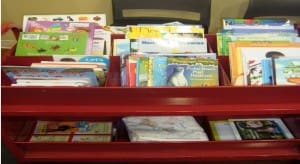 able to provide our families day in and day out. The facts are, the challenges that our families face are multifaceted and if we can help to alleviate any issue we are doing a service to the community. That’s why our relationships with other community organizations are so important and is the reason why we have been able to really make an impact.
able to provide our families day in and day out. The facts are, the challenges that our families face are multifaceted and if we can help to alleviate any issue we are doing a service to the community. That’s why our relationships with other community organizations are so important and is the reason why we have been able to really make an impact.